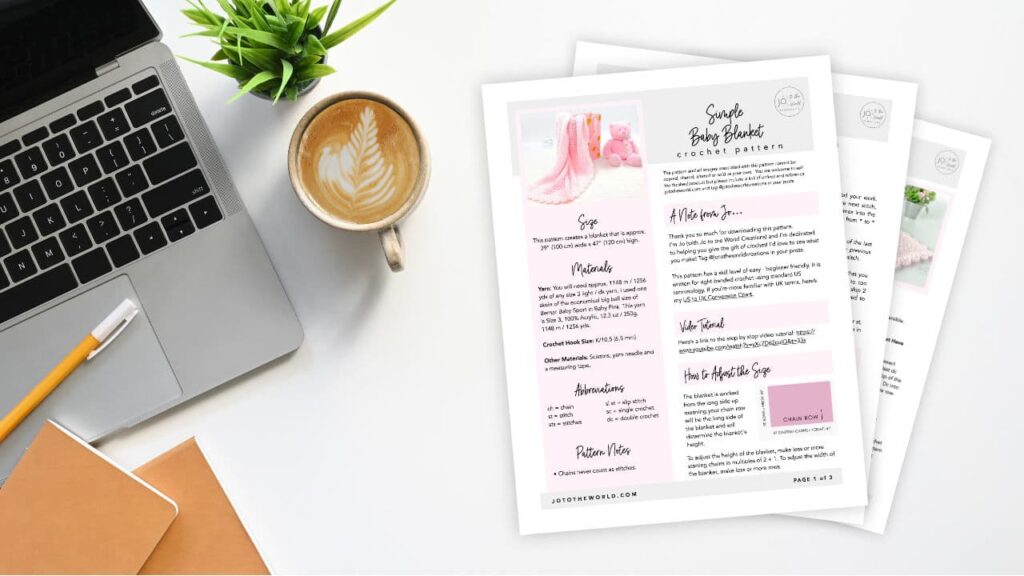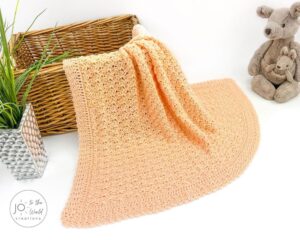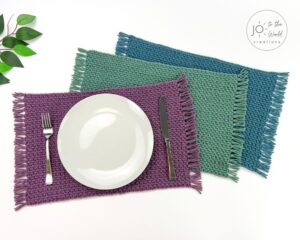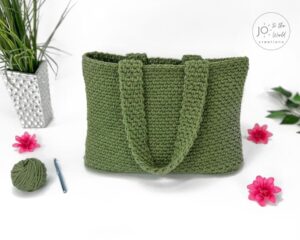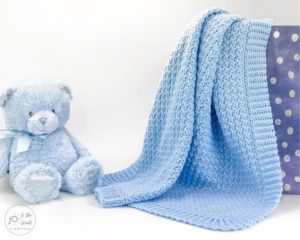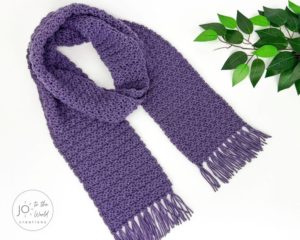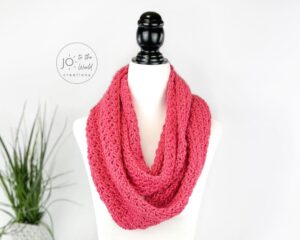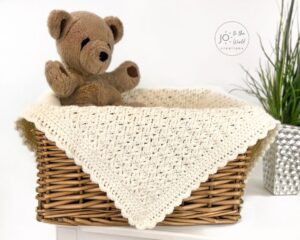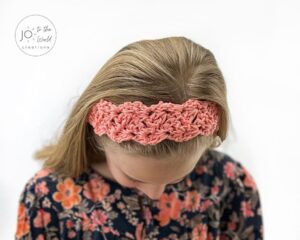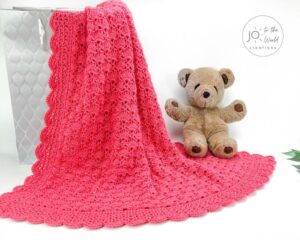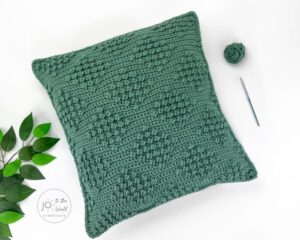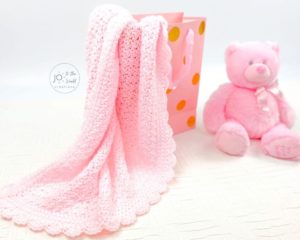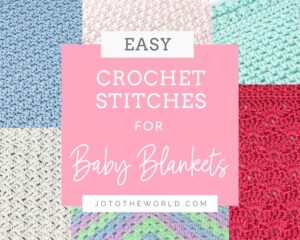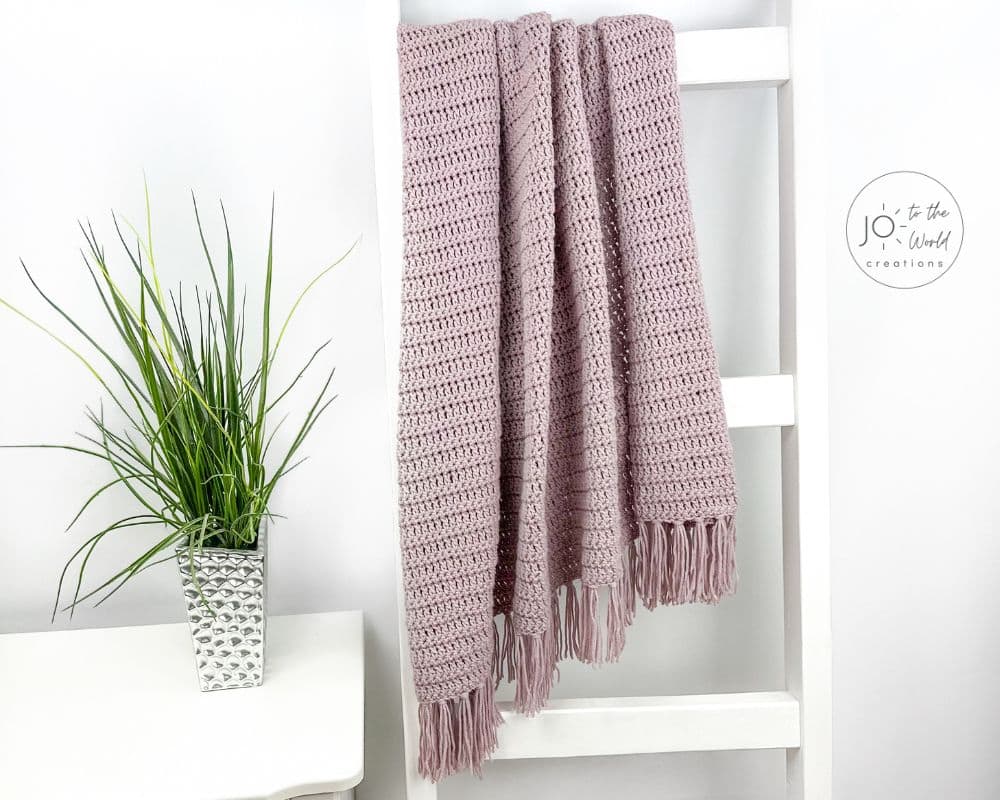
How to Crochet a Throw Blanket for Beginners
Learn how to crochet a throw blanket and make this gorgeous, cozy, reversible and very easy Beginner Throw Blanket Crochet Pattern with photos and a video tutorial! It’s the ultimate step-by-step guide to making a crochet blanket for beginners!
Before we begin, I would like to thank you for visiting Jo to the World Creations, a site dedicated to helping you give the gift of crochet.
More free patterns (that make awesome crochet gifts) are on the way! Sign up for my emails, follow me and never wonder “What should I make for…” again!
FREE PATTERNS FOR CROCHET GIFTS
Delivered to your inbox
AND GET A FREE PDF OF THE LOVE PILLOW
& A FREE CROCHET CHEAT SHEET
Unsubscribe at any time.
Delivered Socially
Follow Me on
Crochet Throw Blanket Pattern for Beginners
If you are new to crochet and would like to learn how to crochet a throw blanket, this Crochet Throw Blanket Pattern for Beginners is for you! It’s also great for experienced crocheters looking for a relaxing project.

With diagrams and a full video tutorial, this step-by-step comprehensive guide on how to crochet a throw blanket includes everything you need to know and will teach you from start to finish how to make this gorgeous, snuggly, reversible crochet throw blanket.
This blanket makes a beautiful addition to your living room or wherever you would like to cuddle up under a classic throw blanket.
You can jump right to any part of this pattern using the Table of Contents below.
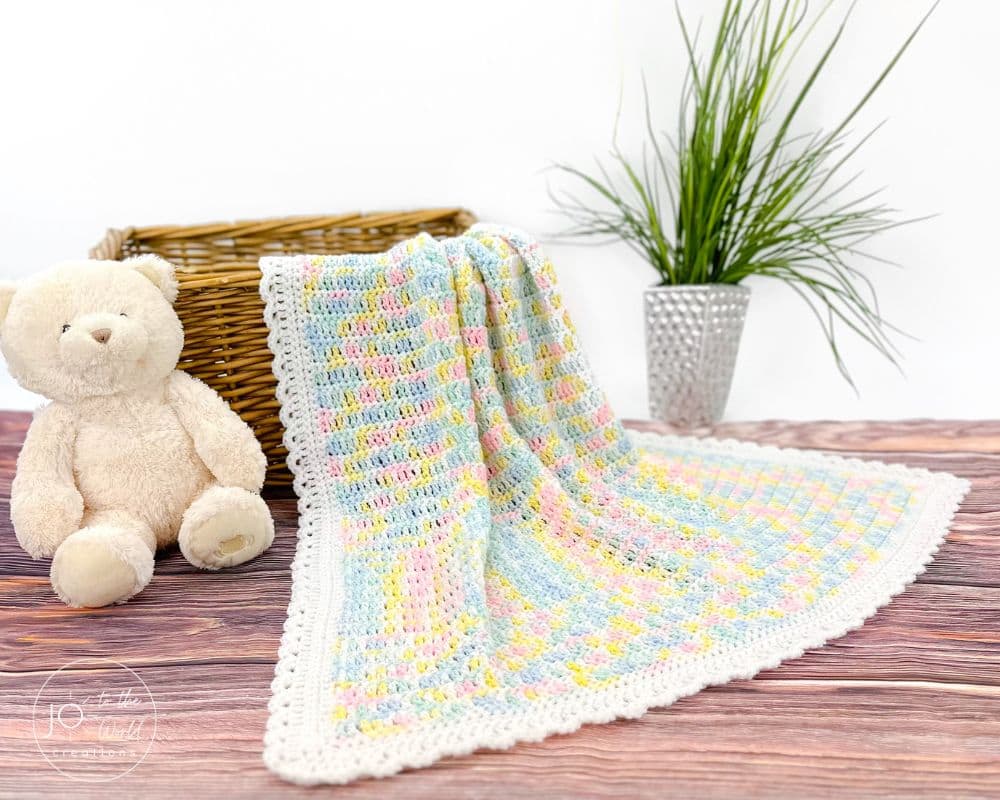
Looking to make a baby blanket instead of a crochet throw blanket? Learn How to Crochet a Baby Blanket for Beginners.
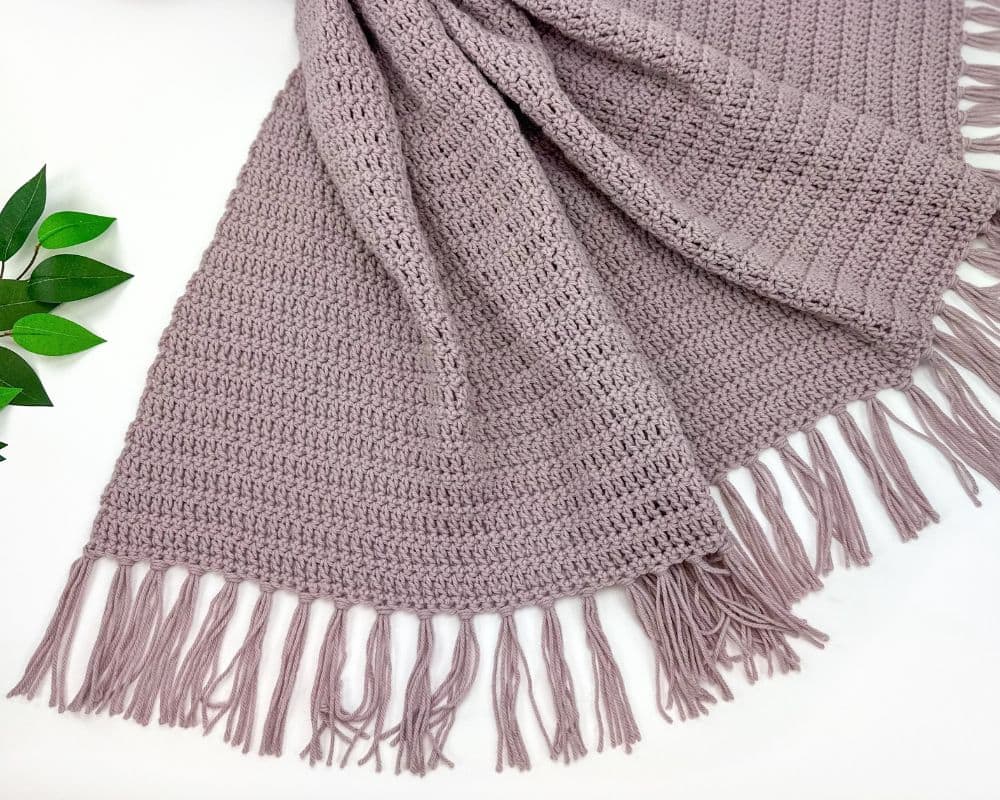
What Do You Need to Crochet a Throw Blanket?
There are six essential crochet supplies you will need to make this throw blanket:
- Yarn
- A Crochet Hook
- Yarn Needle
- Scissors
- Stitch Markers
- Measuring Tape
Yarn
Yarn comes in all different sizes and has different levels of thickness. To help people who use yarn regularly, such as knitters and crocheters, yarn is classified into categories called “yarn weights.”
Yarn weight is determined by the thickness of the strand of yarn, not by how much the skein (the ball of yarn) weighs. There are eight categories of yarn weights. They range from Size 0, which is the smallest (thinnest) to Size 7, which is the largest (thickest).
The image below shows yarn strands that are Size 1 to Size 6:
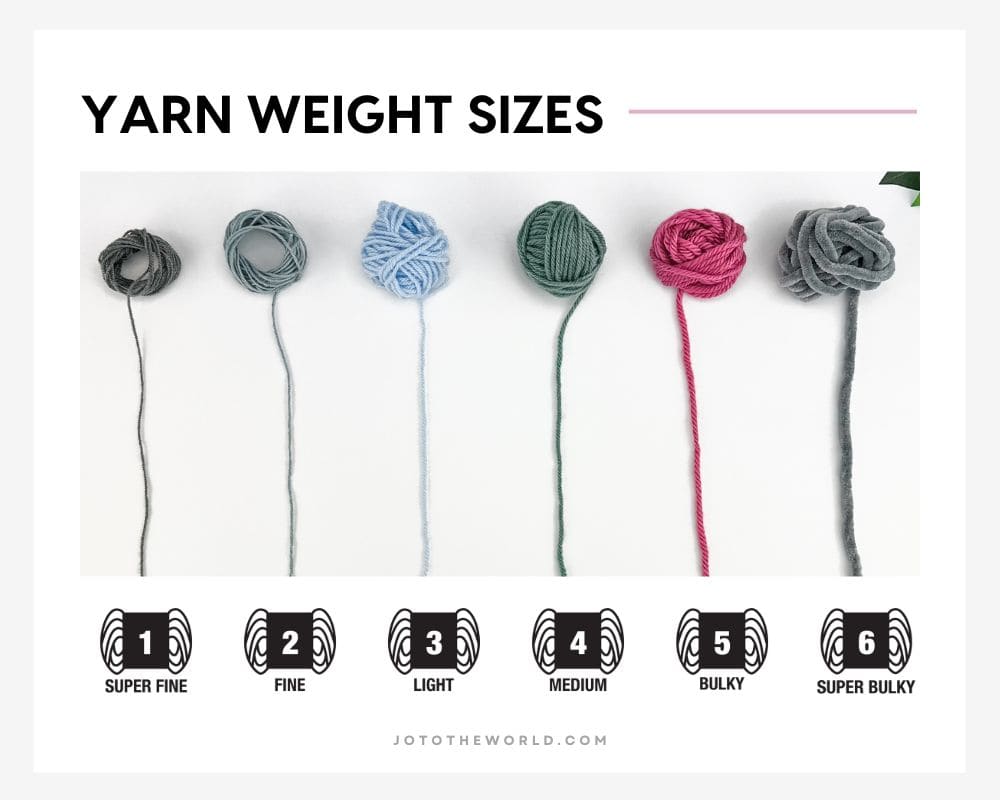
It’s important to understand the different yarn weights as the size of the yarn you use plays a very large role in determining the overall size, look and feel of your crochet project.
There are also different types of yarn such as cotton, acrylic and polyester. The type of yarn also impacts the finished result of your project.
Learn more by reading my Guide to Yarn Sizes/Types & Yarn Weight Chart.
Recommended Yarn Weight & Amount of Yarn Required
When following a pattern for a crochet blanket, you will see a section called Materials or Yarn, which includes the yarn details for that pattern. These details include the recommended yarn weight as well as the amount of yarn required.
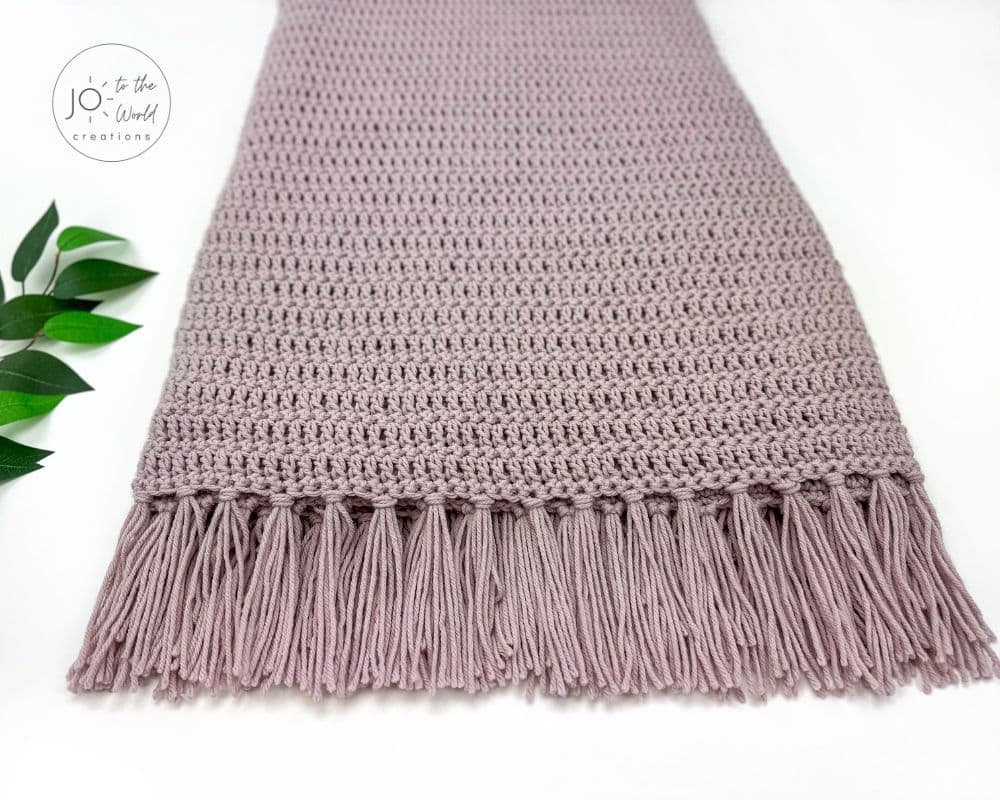
For this Beginner Throw Blanket Crochet Pattern, here is the recommended yarn weight and amount of yarn required:
- You can use any size 4 (medium) yarn. You will need approx. 2,340 yards in total.
- I used Pound of Love by Lion Brand in the color “Quartz.” This yarn is size 4 (medium) and 100% acrylic. A skein is 1,020 yds / 932 m and 16 oz / 448 g. I used 2 and 1/4 skeins.
Let’s go through what this means:
If you want your finished blanket to look as close as possible to the pictures, you can use the exact same yarn as the designer. In this example, you would get 3 skeins of Pound of Love by Lion Brand in the color “Quartz.” Then you can start crocheting the blanket!
But what if you can’t find that yarn or want to use a different brand?
You can absolutely use a different brand of yarn. This is when you want to understand yarn weights and types to ensure that the yarn you select will work for the pattern.
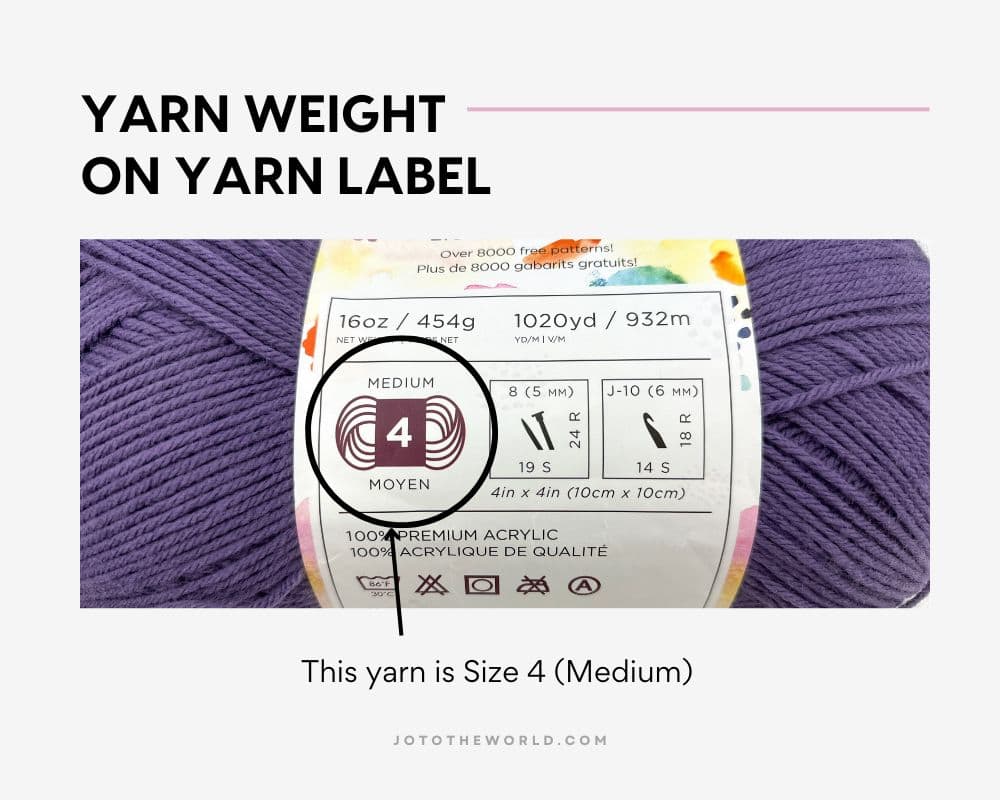
First, you will want to ensure you are using the correct yarn weight. The yarn weight is listed on the yarn label. If the pattern calls for a size 4 (medium) yarn, you’ll want to use yarn in that same weight category.
The most frequent question I receive is “can I use a different yarn weight?”
Here is my answer: you are of course welcome to try! Just know that using a different yarn weight can (sometimes) significantly change the size, look and feel of the design as well as the amount of yarn required. I have designed and tested this blanket using this specific yarn weight and the hook size indicated below. Changes to either of these can create an entirely different design.
And as much as I wish I could help, I can’t recommend a hook size for a different yarn weight or tell you how much yarn you will need using a different yarn weight since I’ve designed, made and tested this pattern using size 4 yarn.
Yarn Types
For this Beginner Throw Blanket, I used a yarn that is 100% acrylic. If you use a yarn that is 100% cotton or a cotton blend (60% cotton & 40% acrylic) for example, the look and feel may be different – or it might not be…or it could be different in a really good way!
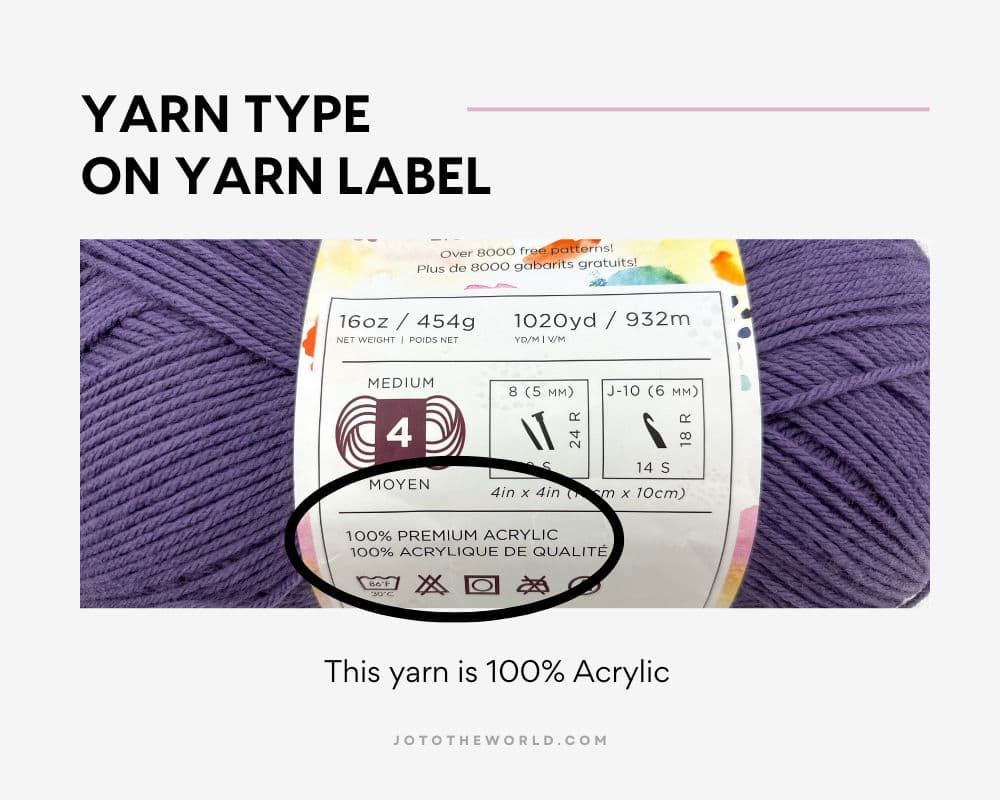
I really wish I could speak to the end result using all the different types of yarn but unfortunately, I can only speak to the type I used and designed the blanket with.
For some patterns, I indicate that you should use a specific yarn type. For example, for crochet dishcloths, I recommend using a yarn that is 100% cotton.
If the pattern does not indicate a specific yarn type, you are welcome to use a different type than I have used as long as you know the look and feel of your finished blanket may be slightly different.

Amount of Yarn Required
For this Throw Blanket Crochet Pattern for Beginners, I used two and a quarter skeins of Pound of Love by Lion Brand. But not all skeins have the same amount of yarn. The amount of yarn in a skein varies significantly by brand.
You’ll want to look at how many yards of yarn are in a skein. If you bought three skeins of a different brand for example, and the skeins only had 100 yds of yarn per skein, you would be significantly short of yarn. Not fun!
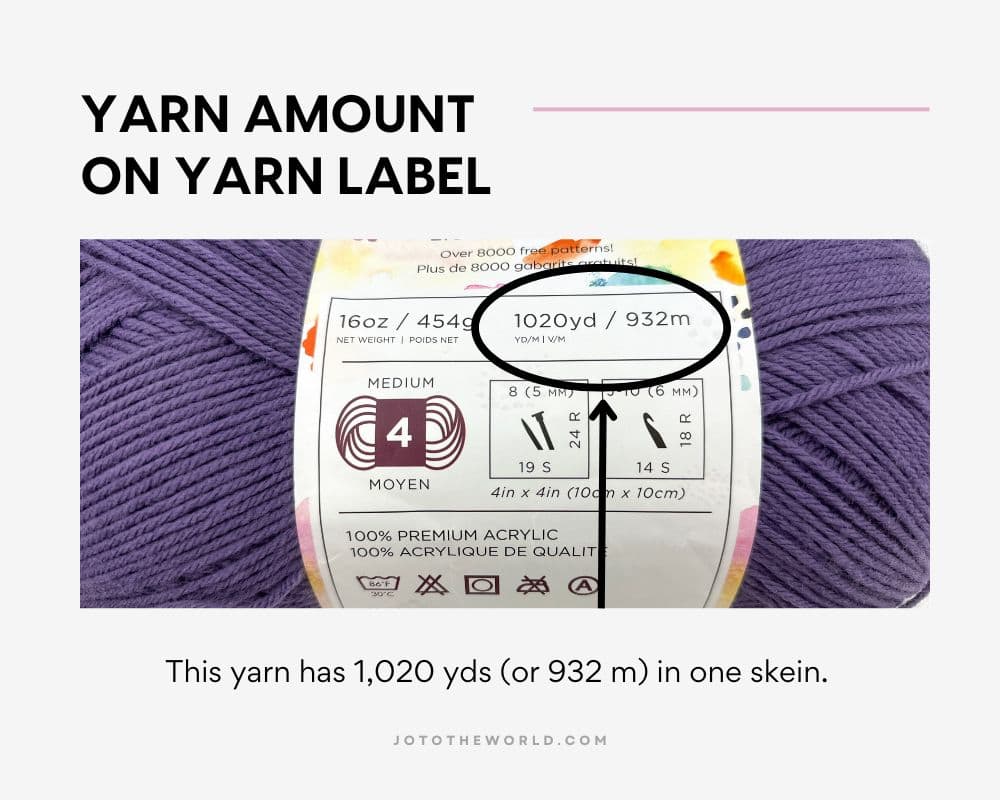
When you find the yarn you want to use, look at the skein label and see how many yards are in that skein. For this pattern, you will need approx. 2,340 yds in total.
If the skein of yarn you’d like to use has 600 yards of yarn, for example, you would need 4 skeins.
Crochet Hook
For this Beginner Throw Blanket Crochet Pattern, I used a K/10.5 (6.50 mm) crochet hook.
Just like the yarn weight and type, the size of your crochet hook has a significant impact on the overall look, size and feel of your work. Learn more in this Guide to Crochet Hook Sizes.
Each yarn weight has a recommended hook size. If you look at your skein of yarn, you may see that it says to use an H/8 (5.00 mm) hook. It is absolutely okay if your yarn label does not recommend using a K/10.5 (6.50 mm) crochet hook. Mixing hook sizes with different size yarns allows you to achieve unique designs.
Scissors
For this pattern, you will need scissors. When you are finished with your yarn, you will cut it, leaving a long tail that you will then weave in with a yarn needle. I cut my tails to be approx. 8″ so that I have lots of yarn to work with when I weave in my loose ends.
Yarn Needle
You will need a yarn needle to weave in your loose ends. When you are finished the blanket, you will put those ends into a yarn needle and weave them into the stitches. A yarn needle (also called a Tapestry needle) has a larger eye than a sewing needle so that you can easily thread your yarn into it. You can use plastic or metal yarn needles.
Stitch Markers
For this pattern, you will need two stitch markers. I used safety pins but you can use any type of stitch markers you would like.
Measuring Tape
A measuring tape is not absolutely necessary but if you are going to check the gauge or measure the height of the blanket before adding the tassels, you will want a measuring tape.

Optional: A 6″ Object
The pattern includes instructions for adding tassels (also called fringe) to the finished blanket. You will need to cut a number of strands to make those tassels. To make cutting those strands easier, you can use an object such as a piece of cardboard or a notebook that is approx. 6″.
Terminology
In every crochet pattern, you should see somewhere these two essential pieces of information:
- Is the pattern for right or left-handed crochet?
- Does the pattern use US or UK crochet terminology?
This Beginner Throw Blanket Crochet Pattern is written for right-handed crochet using standard US terminology.
Right-Handed vs Left-Handed Instructions
When a pattern notes that it is written for right-handed crochet that means it does not include instructions for left-handed crochet. There are lots of patterns that have instructions for both. Many patterns can be adapted or even followed directly by left-handed crocheters.
Here is more information on Left-Handed Crochet.
This Beginner Throw Blanket and all of my patterns are written for right-handed crochet and unfortunately, I don’t have instructions for how to make them with left-handed crochet.
US vs UK Crochet Terminology
There is a major difference between US crochet terminology and UK crochet terminology. The way you make the stitches are the same but what the stitches are called are almost all completely different.
A single crochet stitch, for example, is a US crochet term whereas the same exact stitch is called a double crochet in UK terminology.
It’s very important to know which terminology the pattern uses else you could make all the stitches incorrectly.
This Beginner Throw Blanket Crochet Pattern uses standard US terminology. If you are more familiar with UK terminology, here’s my UK to US Crochet Terms Conversion Chart.
Crochet Blanket Sizes
There is not one exact size or an established industry standard for what size a crochet throw blanket should be. Recommended sizing can vary significantly between designers and blanket patterns.
Crochet blankets range from 40″ wide x 48″ high for a lap-ghan (a blanket for your lap) to 98″ wide x 110″ high for a king-size blanket. Learn more in this Guide to Crochet Blanket Sizes.
What is the Best Size for a Crochet Throw Blanket?
Crochet throws range in size from 52″ wide x 60″ high for a small throw to 60″ wide x 72″ high for a large throw. The average crochet throw pattern is 56″ wide x 66″ high.
The great thing about crocheting blankets is that the blanket size doesn’t need to be exact. If your throw blanket is smaller or larger than these measurements, it will still be wonderful.

Beginner Throw Blanket Pattern Sizing
Following this Beginner Throw Blanket Crochet Pattern creates a throw blanket that is approx. 53″ wide and 60″ high, which is about the average size of a small crochet throw blanket. These measurements do not include the tassels.
How Many Chains to Make for a Throw Blanket?
Every crochet blanket pattern will require a different number of starting chains. For this Beginner Throw Blanket Crochet Pattern, making 155 starting chains creates a blanket that is approx. 53″ wide.
How to Adjust the Size of this Blanket
This Throw Blanket Crochet Pattern for Beginners is made in multiples of 3 + 2. This multiple refers to the number of starting chains required to ensure the pattern works out. The number of starting chains determines the width of the blanket.
What this means is that you can pick any number that can be divided by 3 and then add 2 to that number. For example, you could pick 90 as that number can be divided by 3 and then you’ll add 2, so in this example, you would make 92 starting chains.
To adjust the height of the blanket, keep making rows until you’ve reached your desired height. The pattern starts with a row of single crochet stitches. Then the pattern has a two-row repeat – a row of double crochet stitches and then a row of single crochet stitches. Ensure you finish the blanket with a row of single crochet stitches.
Abbreviations
In crochet patterns, to stop the pattern from being too wordy, almost all the stitches are abbreviated. There are certain standard crochet abbreviations as indicated by the Craft Yarn Council. If a designer has a special stitch in the pattern that is not on the list of standard crochet abbreviations, it will be in its own section in the pattern, usually called “special stitches.”
In this Beginner Crochet Throw Blanket Pattern, here are the abbreviations that are used:
- st = stitch
- sts = stitches
- ch = chain
- sc = single crochet
- dc = double crochet
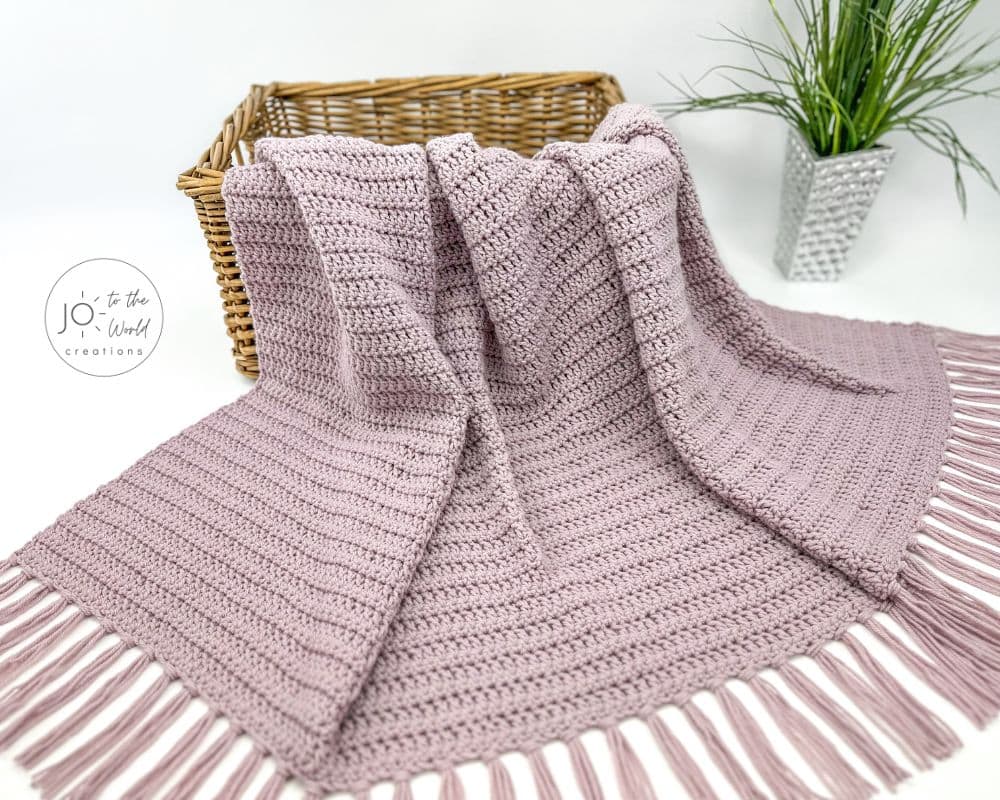
Affiliate Disclosure: This post may contain affiliate links meaning I may receive a commission for purchases made through links in this post at no extra cost to you. As an Amazon Associate, I earn from qualifying purchases.

How to Crochet a Throw Blanket Instructions
Now let’s get to the fun part…crocheting a throw blanket! Here are the instructions for how to make this Beginner Throw Blanket Crochet Pattern.
If you have never crocheted before, you’ll want to know how to hold your crochet hook and how to hold yarn when crocheting.
Video Tutorial
You can watch this step-by-step video tutorial showing how to crochet this throw blanket or keep scrolling down for the written instructions.
Get the PDF!
Purchase the printer-friendly, ad-free PDF of this pattern. The PDF is a condensed version of this Beginner Throw Blanket Crochet Pattern that you can save, print, write notes on and keep forever!
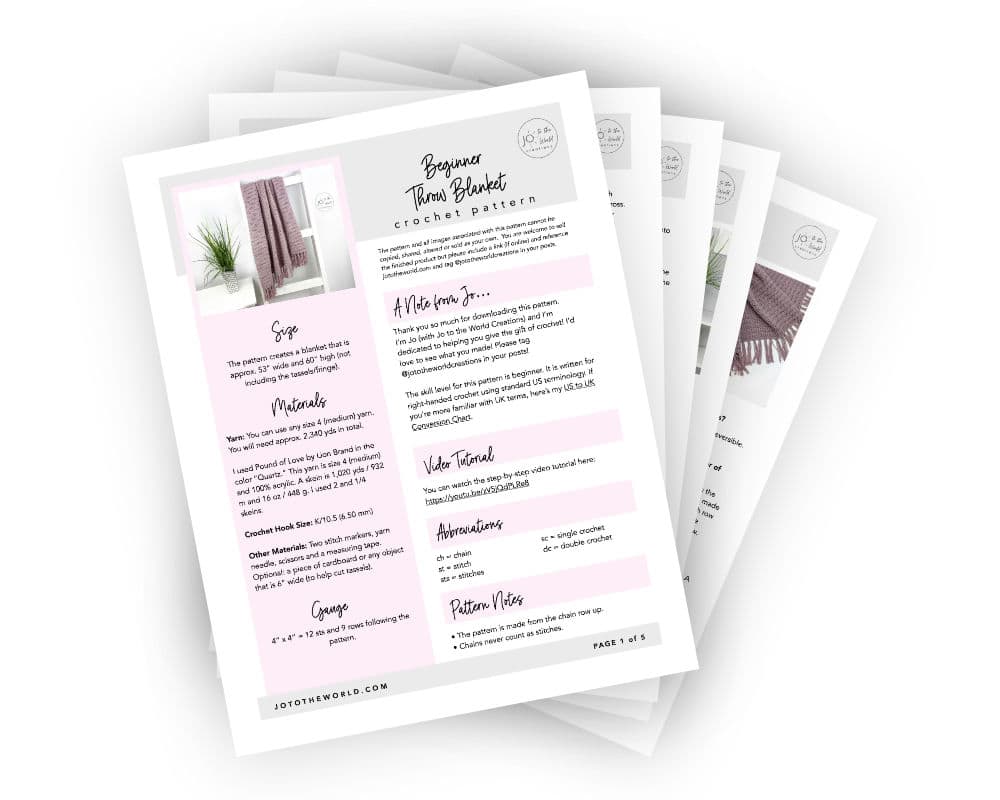
You can also purchase it on Etsy or Ravelry.
[elementor-template id=”22106″]
Start
Almost every pattern starts with making a specific number of starting chains. But what patterns don’t tell you is that you need to make a slip knot to start your chain row. Here are 4 ways to make a slip knot. Once you have a slip knot made, you can begin making your starting chains. In this pattern, we will be making 155 starting chains. This is commonly written as:
Start: Chain 155.
Here is how to start a crochet chain.
Row 1
For Row 1 (only) we are going to be working into the back ridge loops of the chain stitches we just made. These are bumps along the back.
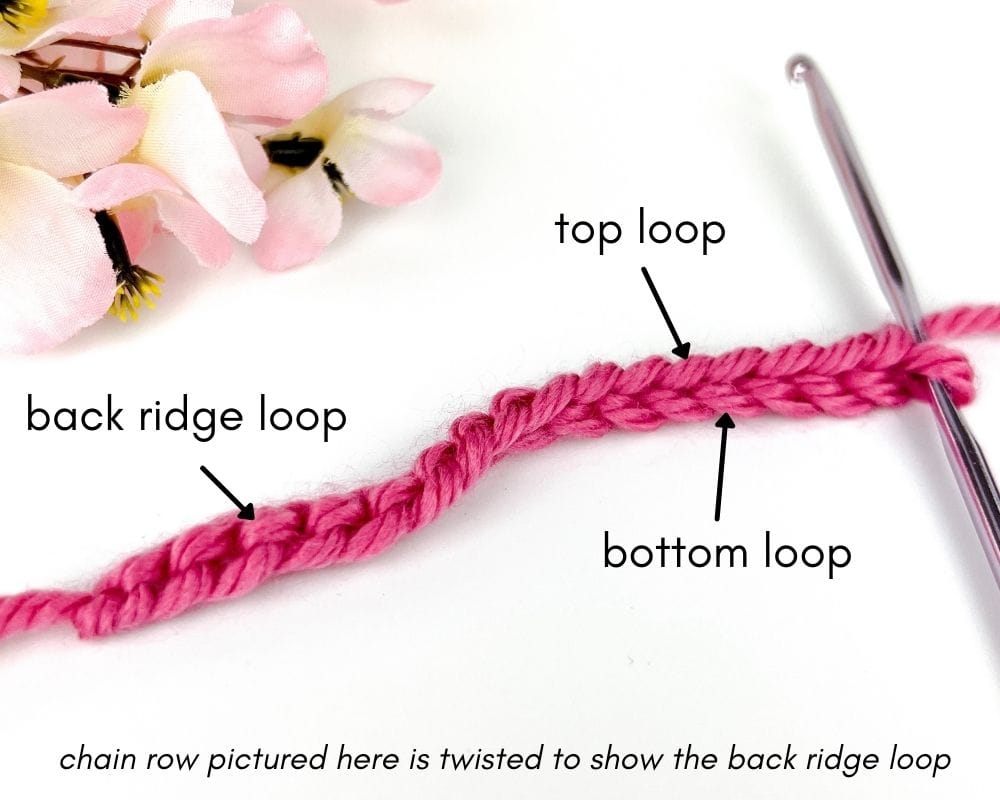
In the second chain (ch) from hook, single crochet (sc) in the back ridge loop.
What this means is to find the second chain from the hook and rotate it so you can see the “bumps” along the back. Insert your hook into the second back ridge loop from the hook and single crochet. Here’s how to single crochet including how to work in the back ridge loop of the second chain from the hook.
Place a stitch marker in the top of that first sc stitch made.
Sc in each ch (in the back ridge loop) across.
What this means is to work into the next chain (in the back bump) and single crochet. Then work into the next chain (in the back bump) and single crochet. And continue making a single crochet stitch into each back bump all the way across the row.
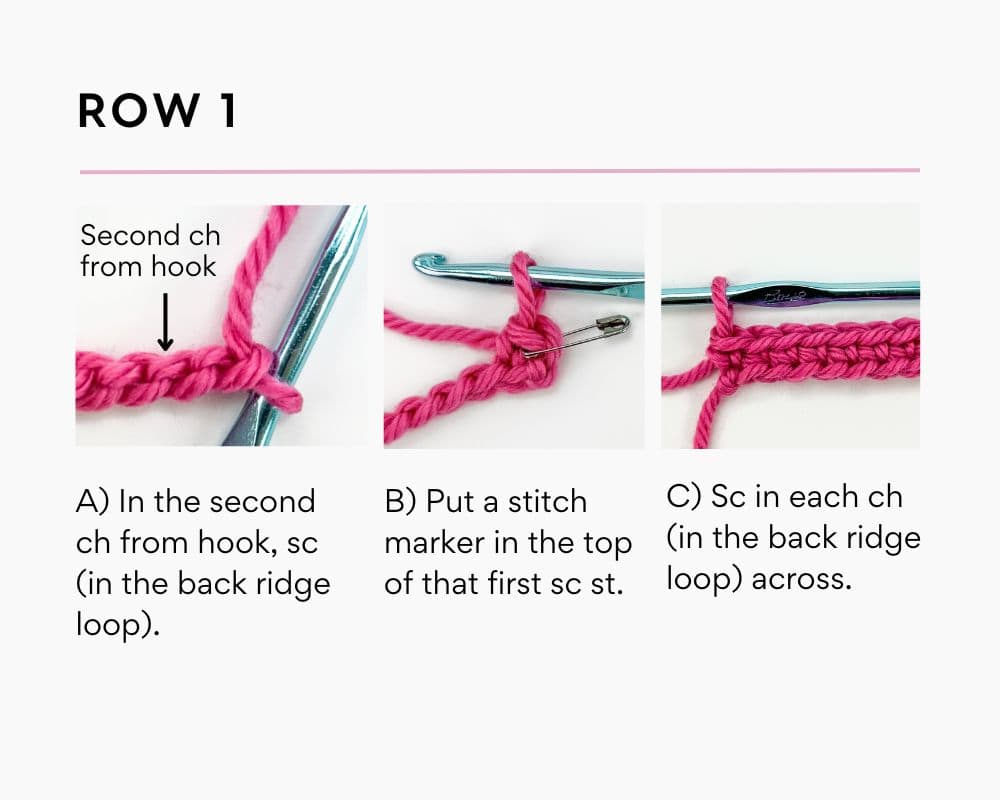
Row 1 Stitch Count:
At the end of the row, you will have 1 less single crochet stitch made than your number of starting chains. Why? Because we skipped the first chain. This skipped chain does not count as a stitch.
If you made 155 starting chains, you should have 154 sc stitches (sts).
Row 2
Ch 2 and turn.
What this means is to make 2 chain stitches and turn your work like you are flipping a page in a book. The back of your work will now be facing you.
In the first stitch (st) (the st attached to the ch), double crochet (dc).
Here is a photo tutorial on how to double crochet.
Put a stitch marker in the top of that first dc st.
Dc in each st across.
Your last st of the row is the st with the stitch marker from the previous row. Remove the stitch maker and make a dc into that stitch.

Row 2 Stitch Count:
At the end of the row, you should have 154 dc sts. Reminder: chains never count as stitches so we don’t count the ch 2 we made at the beginning of the row as a stitch.
Row 3
Ch 1 and turn.
In the first st (the st attached to the ch), sc.
Put a stitch marker in the top of that first sc st.
Sc in each st across.
Your last st of the row is the st with the stitch marker from the previous row. Remove the stitch marker and make a sc into that stitch.
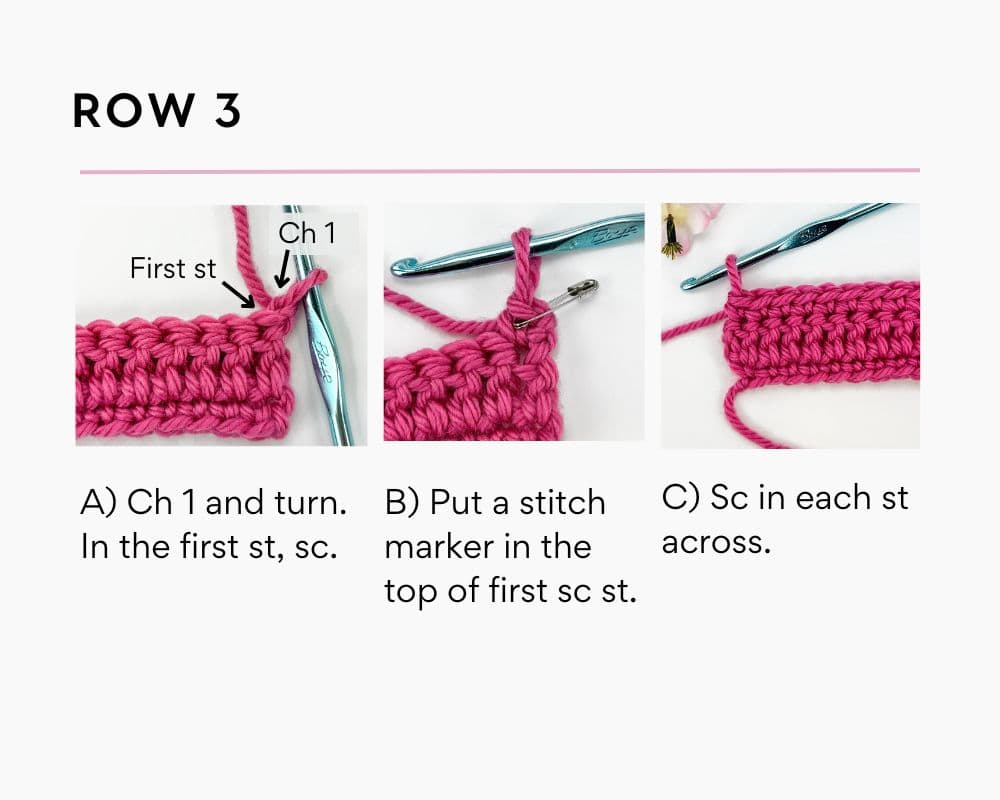
Row 3 Stitch Count:
At the end of the row, you should have 154 sc sts.
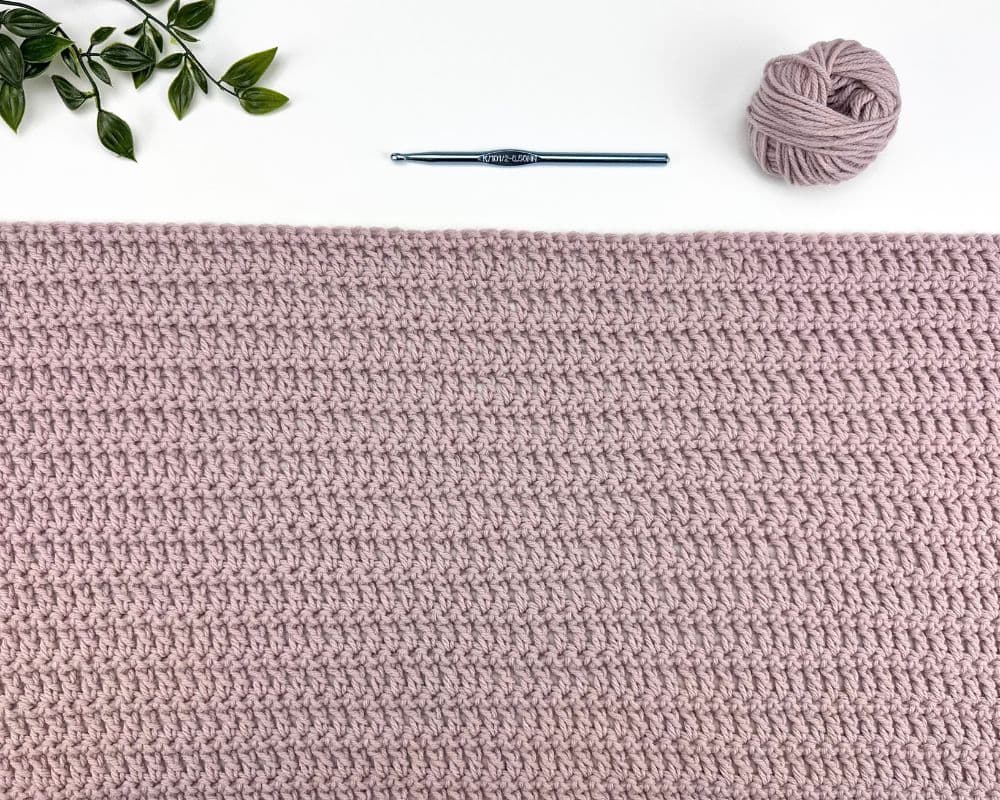
Row 4 and on
Repeat Rows 2 and 3 consecutively until your work measures approx. 60”, which is approx. 127 rows in total. (Or your desired height). The last row before ending should be a Row 3.
Note: It’s okay if your blanket curls slightly. The tassels will fix this.
How to Add Tassels to a Blanket
Now we are going to learn how to add tassels (also known as fringe) to the blanket.
Preparing Your Yarn
Each tassel has 3 strands of yarn that are approx. 12” long. (Once attached to the blanket, the tassel strands are folded so it looks like 6 strands that are 6” long).
You will need 312 x 12” strands in total.
Tip for cutting the strands: find an object that is 6” wide (a piece of cardboard, a notebook, etc). Wrap your yarn around the 6” object a number of times. Cut the yarn in the middle to form individual strands. These 12” strands will be used for the tassels. Repeat until you’ve made a total of 312 strands.
For different sized tassels, cut smaller or larger strands.
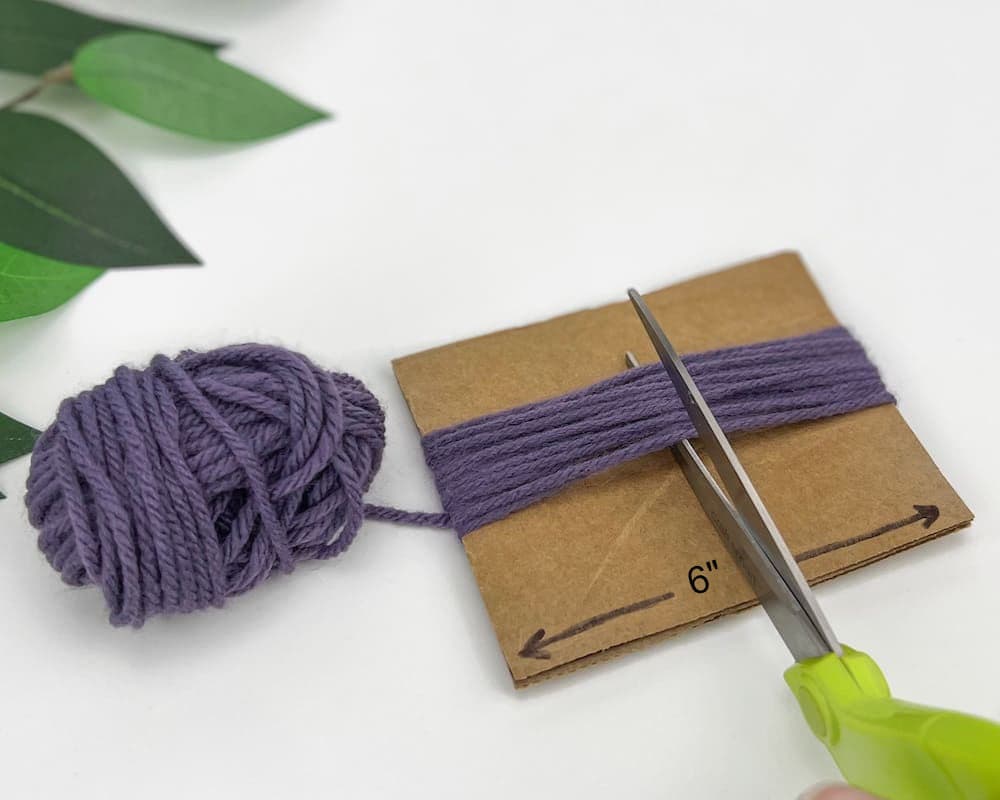
If you are having any trouble with the tassels, the video tutorial for this Beginner Throw Blanket shows you step-by-step how to make, attach and trim the tassels.
Where to Attach the Tassels
Attach the tassels to the top of the finished blanket into the last row of single crochet stitches and to the bottom of the blanket into the chain stitches.
It doesn’t matter whether the front or the back of the blanket is facing you – just ensure it’s the same for the top and bottom.
Attach a tassel to the first stitch. *Skip 2 sts. Attach a tassel to the next st.* Repeat from * to * across. The last stitch will have a tassel.
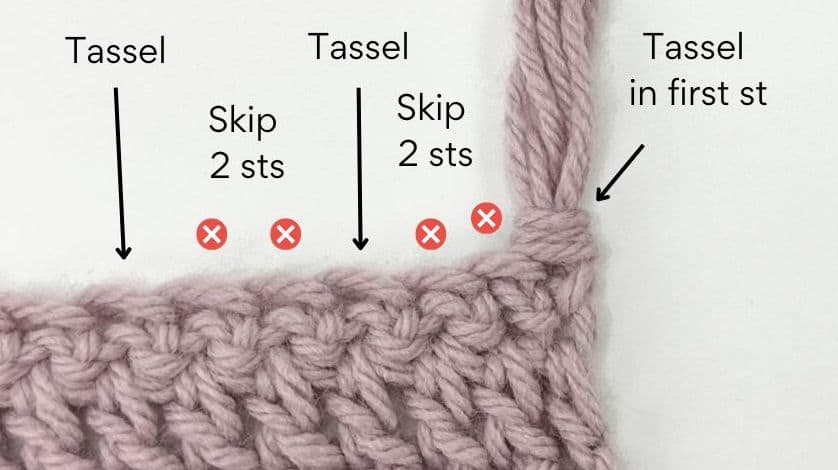
How to Attach the Tassels
A) Take three strands of yarn and fold them in half. With your hook, pull the folded ends through the chain or stitch from the front to the back (which creates a loop).
B) Pull the ends through the loop.
C) Pull tight to make a knot.
(Repeat for each tassel).
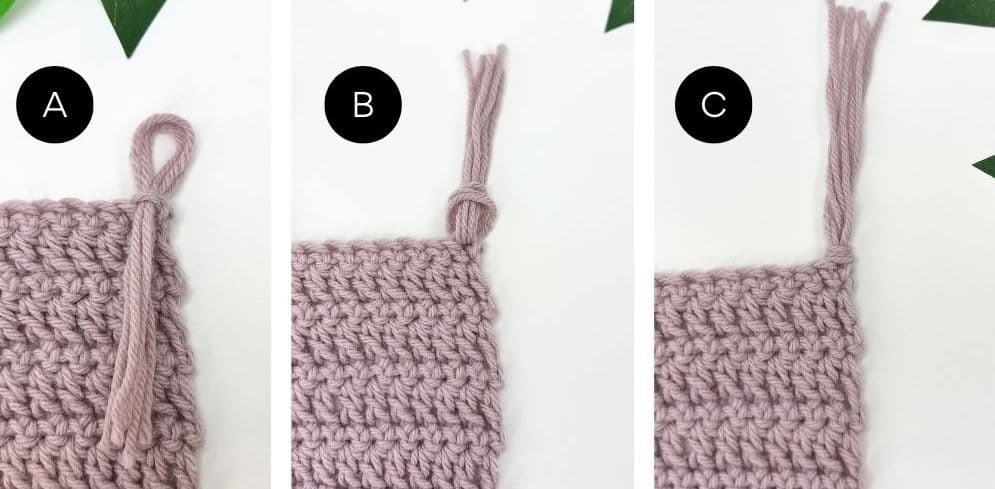
Trimming the Tassels
Trim the strands to make them all one length. I cut mine to be 4”.
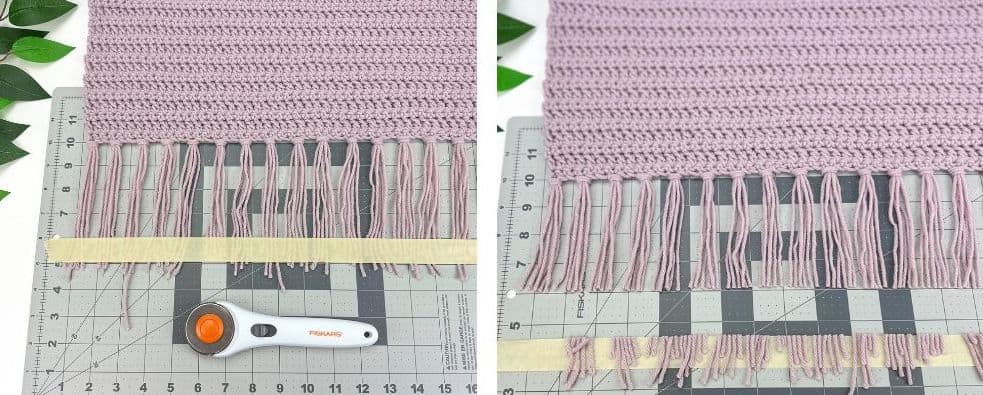
Learn more about adding tassels and how to trim the ends perfectly with this Guide to Tassels & Video Tutorial.

And now you have a new crochet throw blanket!
Frequently Asked Questions
How Many Starting Chains Do I Need to Make a Different Size Blanket?
I often get asked how many starting chains are required to make a blanket that has a width of 20”, 40”, 50” etc. As much as I wish I could help, I’ve designed this blanket to be the size that it is and other than making it again for every size in the world, unfortunately, I can’t tell you how many starting chains are needed. What I can do is share how you can make this blanket to be any size you would like.
- Follow the instruction for making a gauge swatch (outlined below). Even if you aren’t concerned with matching the size of my gauge, this is an important step.
- Count how many stitches are in 4” measured horizontally.
- Divide that number of stitches by 4. That’s the number of stitches per inch.
For example, let’s pretend you have 10 stitches within 4”. If you divide 10 by 4, you will have 2.5. That means you have 2.5 stitches per inch.
Now you can multiply the number of stitches per inch by the width you want your blanket to be.
If you wanted your blanket to be 50” for example and you had 2.5 stitches per inch, you would multiply 50 x 2.5 = 125.
The number you get after multiplying (the number of stitches per inch) X (the width you want your blanket to be) = the number of stitches you will need. Now take that number and round up or down to the nearest multiple of 3. Then add 2. That’s how many chains you’ll need.
Using my example numbers, you can round 125 up to 126 to make it a multiple of 3. Then you would add 2 to that number so you would 126 + 2 = 128 starting chains to have a blanket that is approx. 50” wide.
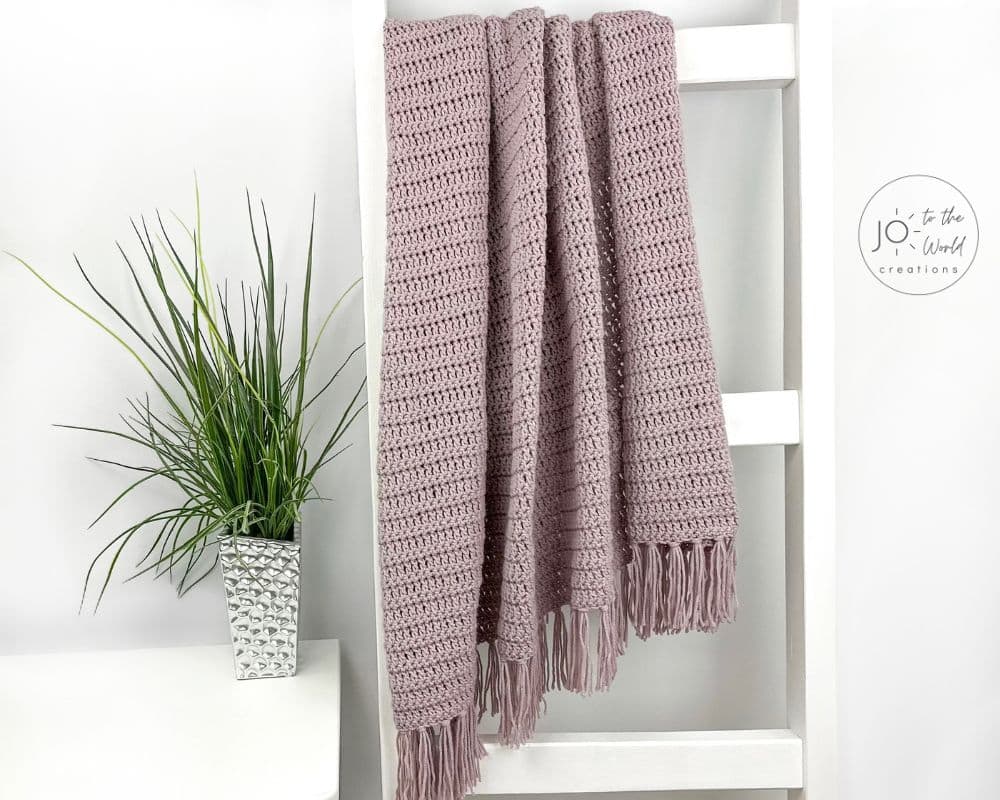
What is the Gauge for this Pattern?
The gauge for this Beginner Throw Blanket Crochet Pattern is 4” x 4” = 12 sts and 9 rows following the pattern.
The gauge of your work is the number of stitches and rows in a designated area. The gauge is most important when you want your work to be the exact same size as the designer. This is critical when making items that need to fit such as garments, pillows and tissue box covers, for example. For things like scarves and blankets, the gauge is not as important because the sizing doesn’t need to be exact. You may want to make a gauge swatch for a blanket if you want to adjust the size and want to see how many chains you will need to do that. Learn more in this Guide to Crochet Gauge.
As stated above, the gauge for this pattern is 4” x 4” = 12 sts and 9 rows following the pattern.
What this means is to make a small sample of the pattern (called a gauge swatch) and count the number of stitches and rows within a 4” by 4” area.
When making a gauge swatch, you always want to make a few more stitches and rows than what is stated for the pattern’s gauge.
For this pattern, there are 12 stitches within 4”, measured horizontally so we will add 4 stitches to that and make a gauge swatch with 17 stitches across.
The gauge says there are 9 rows within 4”, measured vertically so we will make 3 more rows before we measure our swatch so a total of 13 rows.
To make our gauge swatch, we are going to follow the pattern but instead of making all the starting chains we need for the blanket, we are only going to make 15 + 2 = 17 chains (since the pattern says we can adjust the number of starting chains in multiples of 3 + 2).
Unless you know for sure that you are a very tight crocheter or a very loose crocheter, always do your first gauge with the recommended hook size. In this pattern, the recommended hook size for size 4 yarn is K/10.5 (6.50 mm). If you don’t have this size hook, use the closest hook size you have.
For our gauge swatch, we are going to chain 17. Then follow the instructions for the pattern.
- At the end of Row 1, we will have 16 sts. This is because we worked in the second chain the from hook so we skipped the first chain.
- At the end of Rows 2 & 3, we will also have 16 sts since chains in this pattern don’t count as stitches.
- Repeat Rows 2 & 3 of the pattern consecutively until you have 12 rows in total.
Now we take our measuring tape and hold it parallel to the row. (If you are using a gauge ruler, place it in the middle of your swatch). Count the number of stitches within 4”. As a reminder, half stitches count too so if it is half a stitch or more, count it as a stitch. Make note of how many stitches you have in that 4” area.
Next, we will measure the number of rows. Hold the measuring tape vertically, parallel to the two sides. (If you are using a gauge ruler, keep it in the middle of your swatch). Count the number of rows within 4”. Half rows count too so if there is half a row or more, count it as a row. Make note of how many rows you have.
Since the gauge swatch doesn’t specify, we count both rows of single crochet stitches and double crochet stitches and it doesn’t matter which row starts and ends.
Compare your stitches and rows to the gauge listed on the pattern. The pattern states that there should be 12 sts and 9 rows. If you have the same, great! You can now make the blanket.
- If you have MORE stitches and/or rows than what the pattern gauge states, your finished item will be too small and might not fit (plus you’ll have lots of leftover yarn). Redo your swatch with a LARGER hook.
- If you have FEWER stitches and/or rows than what the pattern gauge states, your finished item will be too big and you might not have enough yarn. Redo your swatch with a SMALLER hook.
What if you have the same number of stitches but not the same number of rows? That means that you crochet slightly differently than the designer. For this blanket that is absolutely okay. It just means you might need to make fewer or more rows and you may require less or more yarn to complete the blanket. In other patterns, where sizing is more important you may need to try additional techniques to achieve the stitch height as the designer.
Can I Use Size 3 (Light) / DK Yarn?
I have designed and tested this blanket using size 4 (medium) yarn. Using a different yarn weight can sometimes significantly change the size, look and feel of the design as well as the amount of yarn required. With all that said, you are welcome to try it! I unfortunately can’t provide recommendations for what hook size to use or how much yarn you’ll need as this blanket was designed and tested using size 4 (medium) yarn.
If you are looking for blanket patterns that use size 3 (light) yarn, you may like these:
What is the Best Stitch for a Blanket?
There are so many crochet stitches that make beautiful blankets. I’ve put together a collection of my favorite simple stitches that can be used for baby blankets or full-size blankets here: Easy Crochet Stitches for Blankets.
Do You Have More Crochet Patterns for Beginners?
I sure do! Here are more patterns for beginners you might like (and they all have full video tutorials):

Beginner Baby Blanket Crochet Pattern
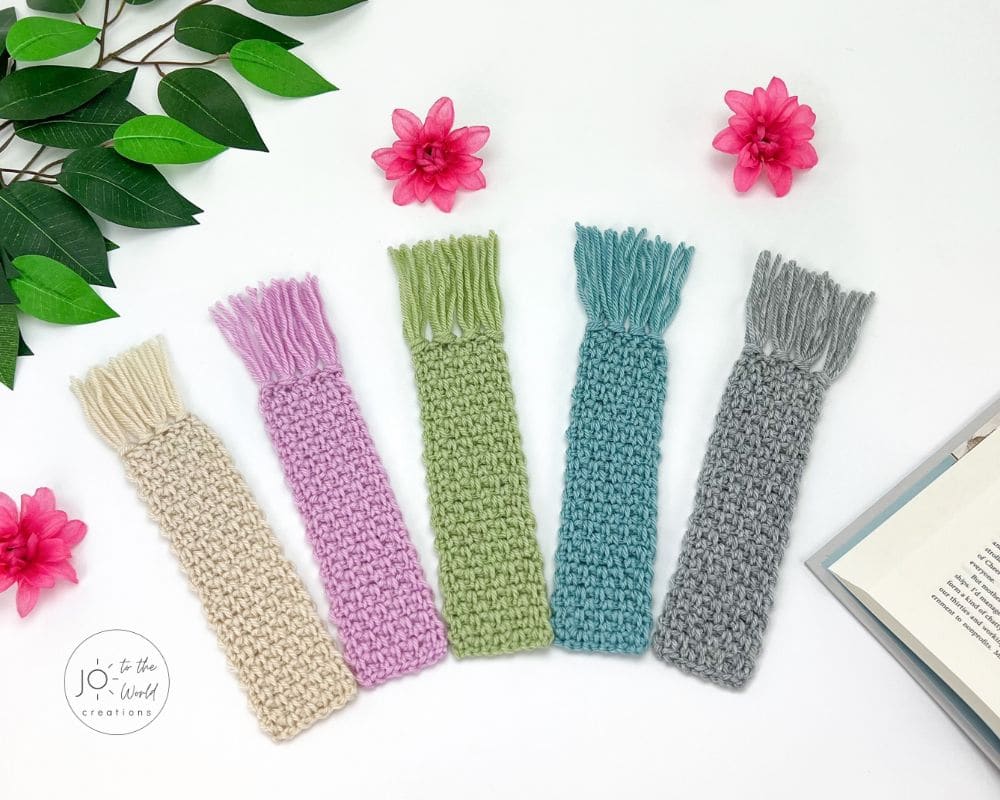
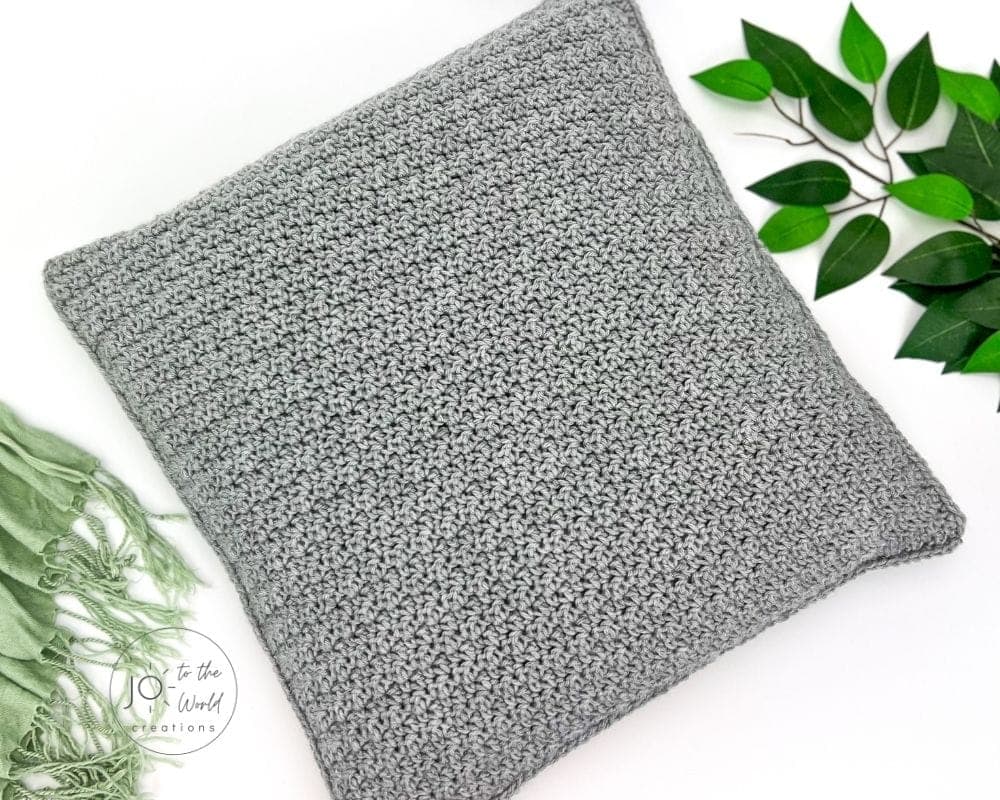
How to Crochet a Pillow for Beginners
And you can find more easy patterns in this collection of 70+ Crochet Patterns for Beginners.
Download. Print. Keep.
Get Instant Access to ALL Printable Patterns
Make your crocheting more enjoyable, relaxing and productive with printable PDF patterns.
- 100+ premium crochet patterns.
- Download, save and print from any device.
- No ads or popups!
Not sure yet? Take a look at the Pattern Library and see all the patterns you can download once you’re a member.

Save with Pattern Bundles
For a limited time, I’ve grouped some of my most popular crochet patterns and I’m offering them as pattern bundles where you can get the printable versions for one low, discounted price. Check out these incredible Crochet Pattern Bundles.

Easy Baby Blanket Bundle
With this Easy Baby Blanket Bundle, you’ll get SIX easy crochet baby blankets as printable downloads. Each pattern includes step-by-step instructions and a full video tutorial.
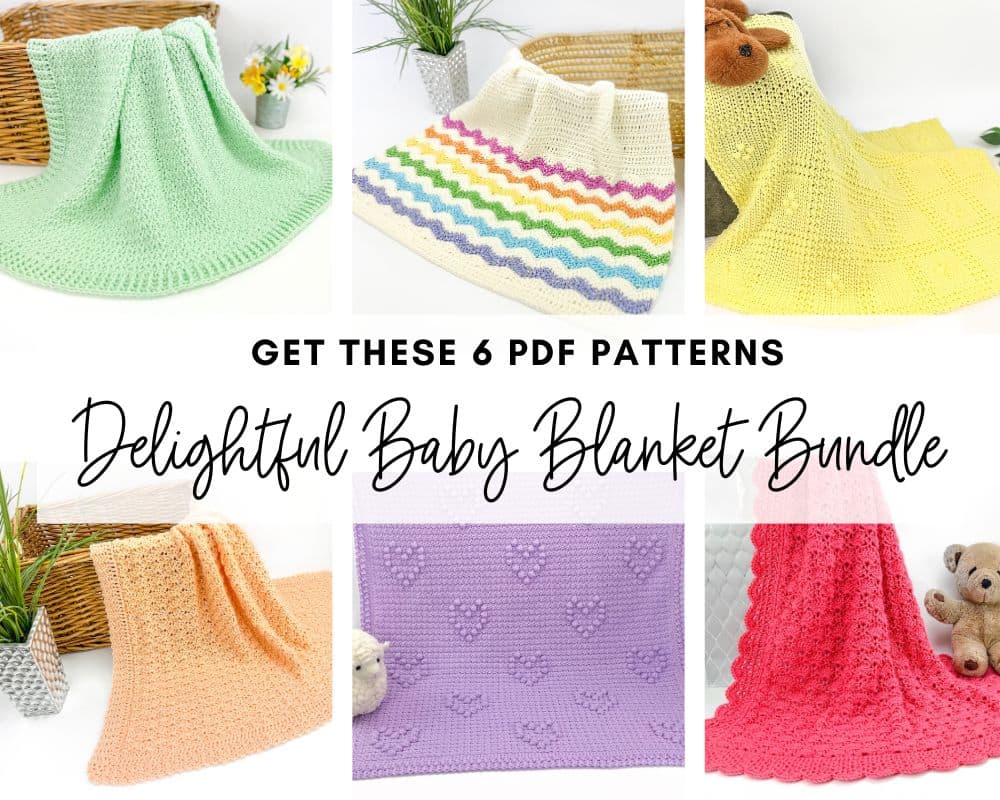
Delightful Baby Blanket Bundle
This incredible deal includes six SIX blanket patterns that are a delight to make and create truly stunning blankets – all as printable PDFs for one low, discounted price.
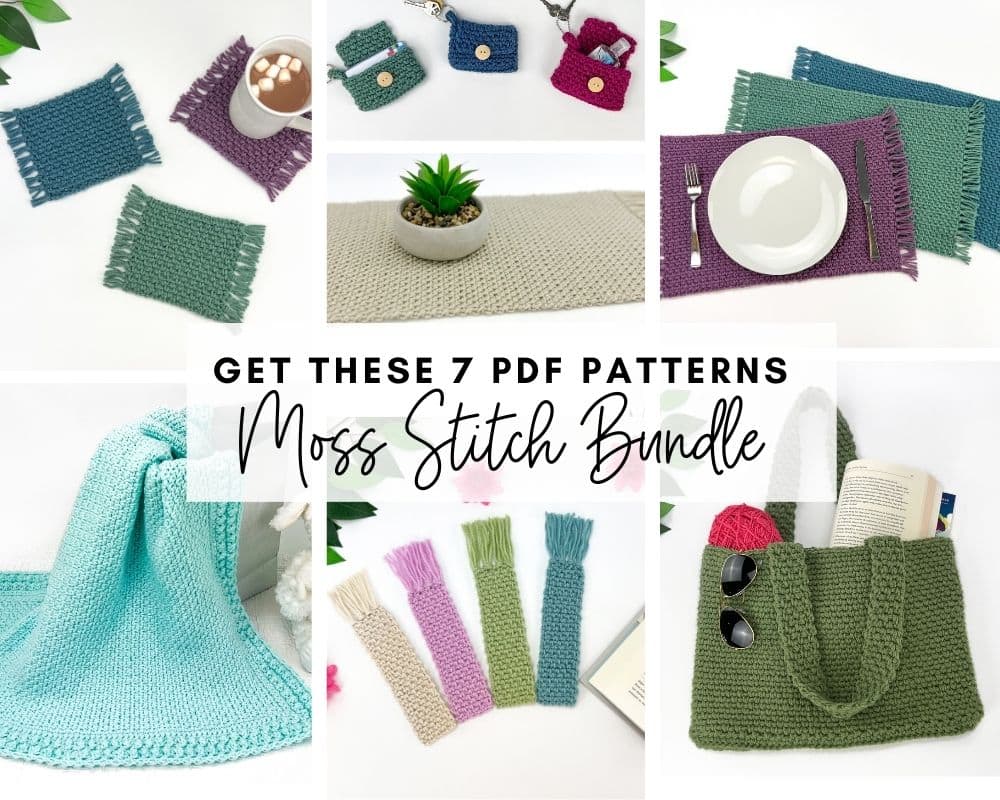
Moss Stitch Pattern Bundle
All your favorite Moss Stitch patterns in one bundle! Get SEVEN easy Moss Stitch crochet patterns as ad-free, print-ready PDFs to print, save and keep forever.
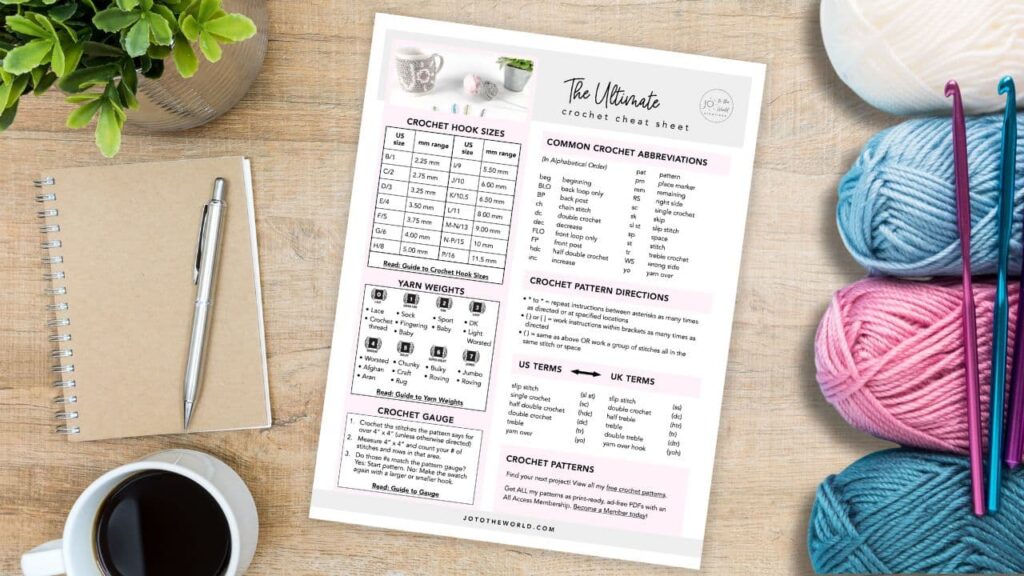
Free Crochet Cheat Sheet
Get instant access to this Ultimate Crochet Cheat Sheet! Plus you’ll receive free patterns for crochet gifts delivered right to your inbox!
Featured Crochet Patterns
Pattern Collections
Free Patterns for Crochet Gifts
Never miss a pattern! Get all my secrets to making incredible crochet gifts as well as new free crochet patterns and exclusive deals when you sign up for my newsletter (it’s free!).





